Written by Anthony Roach
So, you last heard from the ID Trainers with Mike Waller as we were close to finishing Phase 2 of the traineeship. It now comes to me to update you on our exciting goings on in Phase 3.
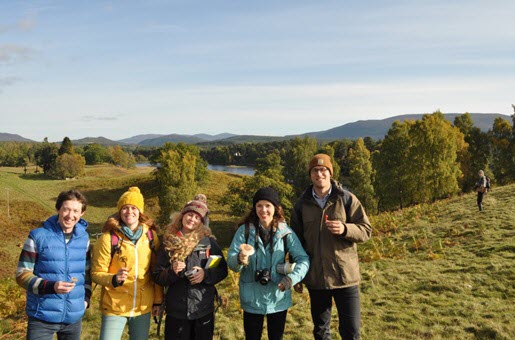
My name is Anthony Roach and like the brilliant Mike Waller, I am a naturalist who has been inspired by the natural world for over 10 years, whether it’s volunteering to assist with bioblitz’s or wildlife festivals, helping with recording schemes or championing science and natural history to the public as a Science Educator at the Natural History Museum. I get excited by squishy, chitinous invertebrates and wetland birds in particular and in 2012 I challenged myself to visit remote New Zealand to see some of the rarest and most beautiful birds on earth. The experience was life changing and it fired my curiosity and desire to discover species wherever I went. Although my degree is in Archaeology, following my graduation I volunteered with natural science collections at Plymouth City and Exeter’s Royal Albert Memorial Museums. I spent over 5 years working on collections-based projects and inspiring public audiences delivering natural history object-based learning activities.
The traineeship so far has allowed all of us to meet many passionate naturalists, field biologists and curators through an amazing mixture of field identification training, identification courses and a three month curatorial placement at the Natural History Museum. In Phase 3 we have been lucky enough to choose from an interesting array of projects.
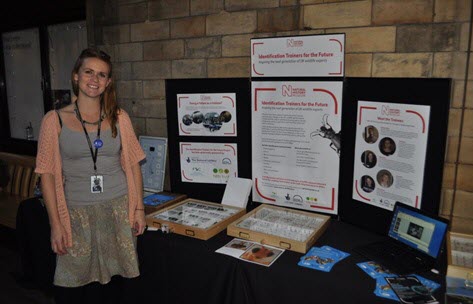
Trainee Chloe Rose has arguably had one of the most challenging of all projects. Her passion for bees and wasps led her to team up with Dr. Gavin Broad, Curator of the Ichneumonnidea and Vespoidea collections at the Natural History Museum. The Ichneumonidea are a group of parasitic wasps and one of the largest of the Hymenoptera groups with an impressive 7,770 species, of which there are 60 families and 18 super families. Her job has been to spend 3 months clarifying the ID characters of a particularly obscure and understudied tribe within the subfamily Ctenopelmatinae. The end result has been to id, photograph and develop a key to aid better identification of this group for naturalists everywhere.
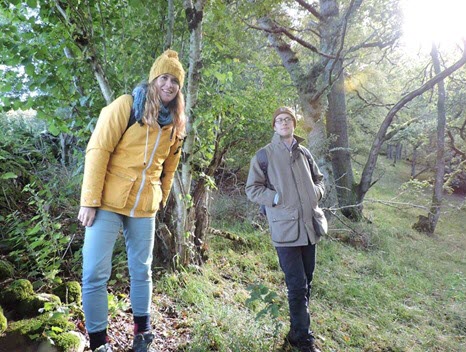
Mike Waller, already well known for his passion for Orchids who spent time launching this year’s Orchid Observers project, decided to join the brilliant Dr. Holger Thues and sidestep into the fascinating world of Lichens. Lichens are also one of the more cryptic species groups and identification to species and are used as indicators of air quality and pollution levels. OPAL produced the OPAL air quality survey in collaboration with the Natural History Museum focused on the ID of lichens that were nitrogen sensitive or nitrogen loving. Mike’s job has been to prepare the entire 1960s lichen collection of the eminent Francis Rose for incorporation into the wider cryptogamic herbarium within the botany department. This was a painstaking process that involved databasing every specimen, transferring them into archival quality packets and developing data labels before they were transferred to their respective folders. Mike has processed around 650 specimens!
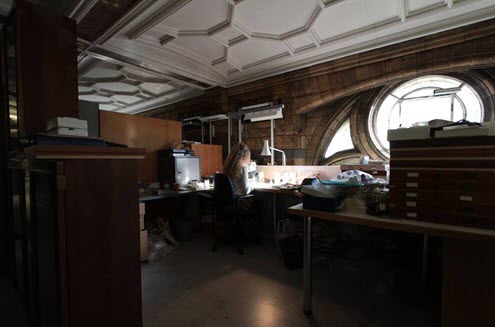
My fellow trainee Katy Potts spends her days encountering, studying and rearing some of the 4000 species of beetles, when she isn’t hula hooping. I can therefore say with some certainty she has probably had the time of her life on her curatorial placement. Katy has been working with Coleoptera Collections Manager Max Barclay to record the beetle diversity of Bookham Common in Surrey. The site has been seen the study of insects by museum scientists for over 50 years. When I’ve bumped into Katy she’s been enthusiastically mounting and describing the species that she has discovered in pitfall traps found in the canopy of this very special nature reserve. An unforgettable experience I’m sure.
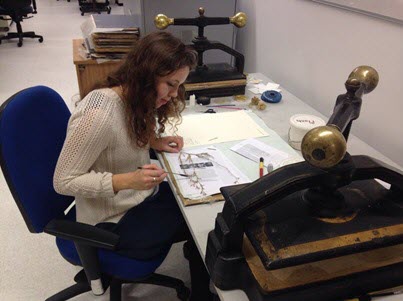
My colleague Sally Hyslop has been drawing (often literally where her beautiful field notes are concerned!) on her exuberance for plants through her curation placement. Sally has been working alongside the very talented Dr. Mark Spencer, Curator of the British and Irish Herbarium who has recently been talking about his natural history hero Sir Hans Sloane for the BBC Radio 4 series Natural Histories. Sally has been assisting Mark’s work by curating the plant specimens from a collection recently donated to the British and Irish Herbarium. This involved re-mounting the plants and labels from old newspapers that they were stored in to archival quality paper. Sally has been “laying in” (a technical term) the specimens into the collection according to taxonomic order and identifying the centaurea (knapweeds) which have now been geographically ordered.
Finally, having relished the time spent in May at FSC Flatford Mill studying freshwater invertebrate groups and in my younger days spending innumerable spring and summer days chasing and identifying dragonflies at local nature reserves in Devon, being asked to re-curate NHM’s UK Odonata collection was a dream project to be involved in.
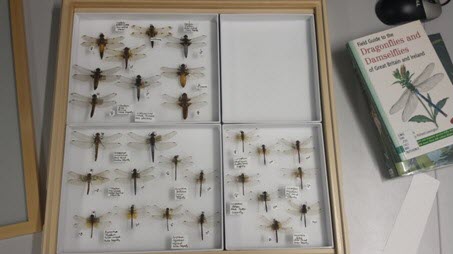
There are 45 resident species of dragonflies in the UK and historically dragonflies were some of the first entomological specimens to be collected and feature in the early 17th century aforementioned collections of Sir Hans Sloane. Partnering with Dr. Ben Price, Curator of Odonata and Small Orders, my job was to assist in re-curating the complete UK Dragonfly and Damselfly collections. This involved re-curating the existing late 19th and early 20th century British collections by taking each individual specimen from its old cork-lined drawer and placing them into new plastazote unit trays, whilst adding a barcode label to every single specimen. With 75 drawers of 50-100 specimens, that is a lot and I assisted volunteers on the project. Secondary to this project was also to create a synoptic collection, database this and to image the collection, which was a wonderfully rewarding experience.
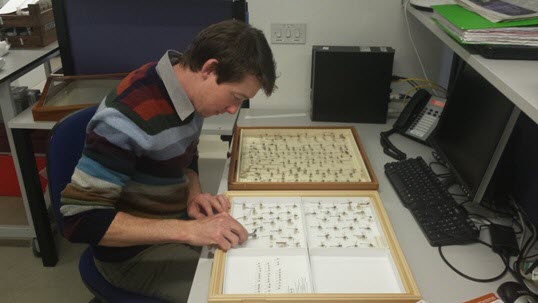
One of the most fascinating parts of the project which Ben is particularly passionate about is how to ensure that the data held on each label is imaged and is accessible. With this in mind, Ben asked me to experiment with imaging dragonfly and damselfly specimens using a camera pitched at different angles. I therefore imaged hundreds of specimens from 8 different compass positions at several angles. The results are still being analysed, but we think that we have come up with an optimum angle at which labels can be read and there exists scripted programmes which can manipulate images so that the label is completely readable, despite being below a specimen. This would make future imaging much more precise and save curators’ time too! It is hoped that the digitisation and subsequent databasing will improve the overall accessibility of this collection for researchers.
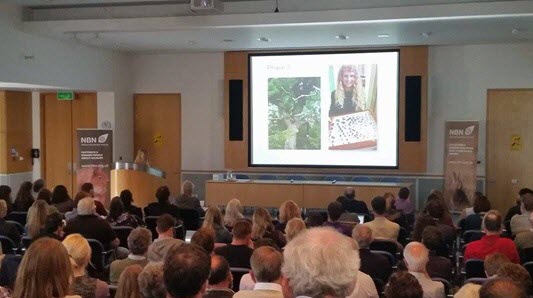
On 19th November, myself and the other trainees had the pleasure of meeting Rachel Stroud and other colleagues at this year’s NBN Conference. I personally thought it was brilliant to see the incredible partnership working taking place between the NBN and organisations to share and use data to manage and conserve wildlife, for lobbying government and to engage people in understanding and recording the natural world. I took the opportunity as did my fellow trainees to network and Katy Potts gave an excellent overview of her experiences and the programme for the traineeship. We would all like to thank the NBN for their continued support for our traineeship. I am certain the late John Sawyer would be very proud of the overwhelming support that the NBN has across the UK. The future of the NBN is a bright one, thanks to John’s and many others vision.
